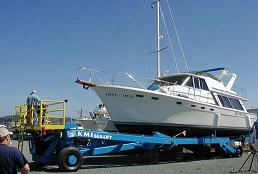Learning how to prepare a boat for shipment can be an exciting challenge, especially if it’s your first time. Make it less stressful with proper preparation and the right shipping partner. No matter what kind of boat you need to ship — whether a powerboat, sailboat, personal watercraft or yacht — getting prepared is the key to a smooth experience.
Preparing your boat for transport is essential to ensure safe, successful transportation. Here are some boat transport prep tips that can help protect your boat from damage and avoid potential disputes.
Canada and the U.S. have various programs and technologies designed to improve efficiency and expedite crossing while maintaining security standards. These include the Free and Secure Trade (FAST) initiative and the NEXUS program for frequent travelers. However, these programs require thorough background checks and compliance with specific security standards. Both countries’ customs agencies are thorough regarding safety, security, and regulatory compliance, making thorough preparation essential for drivers and their carriers. Slight errors in documentation can be costly both financially and time-wise.

The right shipping company takes the hassle out of the process. At Wide Load Shipping, we streamline the process to save you time and ensure your boat reaches its destination safely. We offer numerous services and a team of experienced logistics specialists to streamline the shipping process.
Determine your loaded height to ensure there are no bridge or utility obstructions in the route you plan to take. Once you’ve identified the loaded height, locate a boatyard with a travel lift suitable for your transport route.
When prepping your boat, be sure to take pictures of your vessel when it’s still above the water line and before shipment on the road. Capture from all angles, and remember to turn on your camera’s time and date settings for proper documentation.
Before shipping your boat, check for preexisting damage and declare if there’s any. Remove all personal items from the boat, including food, clothes, linens, electronics and anything not specifically boat-related. All flammables like propane, Sterno cans and emergency flares should also be taken from the boat.
When your boat is out of the water, you need to clean it thoroughly, especially if you’re shipping on the road. Most states and provinces in North America have inspection stations for invasive species. Get rid of any growth from the hull, through-hull valves and fittings for state compliance.
Unplug all battery terminals before draining fuel and emptying all water tanks to prevent leaks. All loose items in the cockpit also need to be taken away. Remove barbecue grills, safety harnesses, man overboard buoys and anchors from the safety rails.
Modify your vessel for safe road travel and lower shipping costs. Some of the ways to limit your boat’s overall shipping dimensions include the removal of:
Know your limitations regarding shipping over the road. States and provinces in North America have specific oversize, overweight and height restrictions you need to comply with to meet all legal requirements. Refer to the latest state regulations to determine the maximums you’re working with on your route.
Before selecting a shipping company, find out how much cargo insurance they allow. You can partner with a specific company even if they don’t have enough cargo insurance, as long as you purchase additional insurance amount from their insurance company. Learn more about boat shipping insurance for safe, cost-efficient transport.
At Wide Load Shipping, we offer expert guidance to make the process as smooth as possible. We can help you with the permits and logistics, providing everything you need for your oversize load transport. Get in touch with us at (877) 792-5056 to get started. You can also submit a quote request today, and we’ll get back to you quickly.